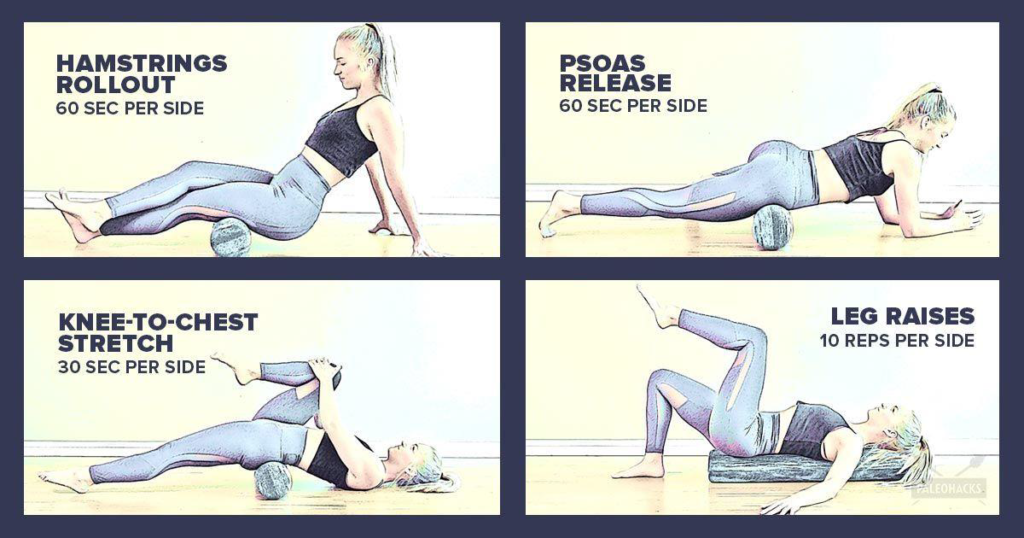Key Facts
- Sciatica is a kind of pain that radiates down your leg from your back.
- Anything that puts pressure on your sciatic nerve or its spinal nerve roots may be the culprit.
- Sciatica usually doesn’t have a major reason and fades away over time.
- Consult your physician if you experience sciatica symptoms.
- Exercise, proper posture, and safe lifting techniques can all help prevent sciatica.
Overview
Sciatica is a type of nerve pain caused by inflammation or injury to the sciatic nerve. Along with discomfort, there may be tingling or numbness that travels down each leg, into the hips, buttocks, and lower back.
The most common cause of sciatica is pressure on the lumbar spine nerve roots from a herniated disk or an excess of bone. Because sciatica impairs movement and causes discomfort, it can have a major negative influence on a person’s quality of life. The majority of persons with sciatica recover on their own with time and self-care techniques, and the condition is typically not severe
or serious. However, severe cases can require surgery. (12792-Sciatica @ My.Clevelandclinic.Org, n.d.)
Sciatic Nerve
The largest and longest nerve in the body is the sciatic nerve. The roots of sciatic nerves extend down the back of each leg from the lower back. It can reach a width of two cm.
The thighs, legs, and feet receive motor and sensory activities from this nerve, which branches off from the lower lumbar and sacral spinal nerves (L4-S3).

Causes of Sciatica
Sometimes there is not any main cause of sciatica. It originates and fades away on ts own with time. But sometimes, following conditions can cause sciatica.
- Herniated Disc: A common cause where a disc in the spine compresses the sciatic nerve.
- Spinal Stenosis: Narrowing of the spinal canal, leading to nerve compression.
- Foraminal stenosis: Narrowing in parts of spine causes compression of spinal nerves.
- Piriformis Syndrome: Compression of the nerve by the piriformis muscle in the buttocks.
- Trauma or Injury: Accidents causing direct damage to the nerve.
- Spondylolisthesis: A vertebra slipping forward over another.
- Osteoarthritis
- Pregnancy
- Degenerative Disc Disease: Breakdown of disks, which act as cushions between the vertebrae.
- Abscess: Body ‘walls off’ a collection of pus and bacteria under the skin or in other areas of body. (Sciatica-Symptoms @ Www.Webmd.Com, n.d.)
Risk factors of Sciatica
- Age. Herniated disks are most common in people between the ages of 20 and 50. As people age, bone spurs become increasingly prevalent.
- Being overweight. The strain on the spine is increased by being overweight.
- Profession. Herniated disks may result from a work that involves bending the back, lifting large objects, or operating a motor vehicle for extended periods of time.
- Extended periods of sitting. Herniated disks are more common in people who sit a lot or don’t move about much than in people who are active.
- Type 2 diabetes. This disorder raises the risk of nerve injury by altering how the body consumes blood sugar.
- A past or present injury. Sciatica is more likely to occur if you have a lower back or spine injury.
- Tobacco. Nicotine usage can alter blood flow and raise your risk of chronic pain that includes conditions like sciatica.
- Smoking
- Wearing high heels all the time
- Endometriosis. Sciatic nerve pain or sciatica-like symptoms that come and go with menstruation may be caused by a chronic inflammatory disease in which tissue resembling the uterine lining forms on other regions of the body.
Pathophysiology
Although the exact pathophysiologic mechanisms generating sciatica are still unknown, compression of spinal nerve roots is known to be linked to both pain and neurological impairment in a segmental distribution of that specific nerve root. The function of the nerve roots may be impacted by compression if it hinders the flow of nutrients to the nerve tissue. Substances escaping from the degenerative intervertebral discs may potentially have a local effect on nerve roots or root sleeves.
Signs and Symptoms
The symptoms of sciatica can range from mild discomfort to severe pain. The hallmark signs include:
- Pain radiating down the leg from the lower back.
- Pain that is shooting, scorching, or sharp.
- Numbness or tingling in the foot or leg.
- Weakness in the affected leg’s muscles.
- Prolonged standing or sitting can exacerbate pain.
- Incontinence of the urine or feces. This symptom is really serious. It indicates that the impulses that regulate your bowels and bladder aren’t getting to their intended locations.
- Redness or swelling in your spine or back
Duration of Onset
The onset and duration of sciatica can vary:

Duration of Onset
The onset and duration of sciatica can vary:
- Acute Sciatica: Lasts 4 to 6 weeks, often self-limiting.
- Chronic Sciatica: Persists for more than 6 weeks, often requiring medical intervention.
Complications
The majority of persons with herniated disk sciatica recover completely, frequently without medical intervention. However, sciatica can harm nerves.
- Sensation loss in the afflicted limb.
- Weakness in the leg that is afflicted.
- Loss of control over the bladder or bowels.
- Drop Foot: A symptom in which you drag your toes when you walk due to weakness or paralysis of certain muscles in your foot.
Tests to diagnose Sciatica
- Computed tomography (CT) scans or X-rays of the spine.
- MRI scans, or magnetic resonance imaging.
- Research on nerve conduction velocity
- Electromyography. evaluates the speed at which nerve impulses pass via your muscles. This is to check if nerves that control muscles are being compressed by a herniated disk.
- Myelogram. imaging test that creates detailed images of the spine using computed tomography (CT) scans or X-rays and a contrast agent.
Treatment
Medications:
- Pain Relievers: NSAIDs like ibuprofen or acetaminophen.
- Muscle Relaxants: To alleviate muscle spasms.
- Steroid Injections: Injections like corticosteroids may provide short-term relief (typically up to three months). These usually involve local anesthesia, so there’s less discomfort.
Physical Therapy:
Finding exercise movements that lessen sciatica by lowering nerve pressure is the aim of physical therapy. - Exercises to build stronger core and back muscles.
- Stretching exercises to release pressure on the nerves.
- Low-impact exercises include water aerobics, swimming, and strolling.

Surgical Options:
Surgery options to relieve sciatica include:
- Diskectomy. This procedure involves removing tiny pieces or fragments of a herniated disk that are putting pressure on a nerve.
- Laminectomy. The lamina is the rear portion of each vertebra; it is located on the side of the vertebra just beneath the back’s skin. Removing a portion of the lamina that is pressing on spinal nerves is known as a laminectomy.
Alternative Therapies:
People occasionally decide to use unconventional approaches to cure their ailments. Compared to other types of lower back pain, sciatica pain may not respond as well to alternative therapies, yet they could include: - Yoga
- Acupuncture
- Chiropractic adjustments
- Massage therapy
Management of Sciatica Pain
- Hot and Cold Therapy:
- For fifteen minutes, apply a cold pack to help reduce inflammation.
- To relieve stiff muscles, use heat therapy afterward.
- Stretching Exercises:
- Piriformis Stretch: Relieves pressure on the sciatic nerve.

- Hamstring Stretch: Reduces tightness in the lower back and legs.
3.Maintaining Good Posture:
- To reduce nerve pressure, try not to slouch.
- For lumbar support, use chairs with ergonomic features.
4.Yoga and Mindfulness:
- Practices like yoga improve flexibility and reduce stress, promoting recovery.
5.Epsom Salt Baths:
- Soaking in warm water with Epsom salts eases muscle pain and inflammation.
6.Maintaining a healthy weight
Signs That Sciatica is improving or worsening
Centralization
- Definition: Centralization refers to the phenomenon where pain moves closer to the center of the spine (lower back) during specific movements, exercises, or postural adjustments.
- Significance:
- o Indicates a positive response to treatment or movement.
- o Suggests that the underlying issue (e.g., disc herniation) is improving or becoming less irritated.
- o Often associated with reduced nerve compression or irritation.
- Peripheralization
- Definition: Peripheralization refers to the opposite phenomenon where pain moves further away from the spine (e.g., into the leg or foot) during certain movements or activities.
- Significance:
- o Indicates a worsening or aggravation of the condition.
- o Suggests increased irritation or compression of the nerve root.
- o This is generally an unfavorable response and signals that the current activity or treatment should be modified.

Frequently Asked Questions
- What are self-care treatments to prevent sciatica?
Hot and Cold Therapy:
- For fifteen minutes, apply a cold pack to help reduce inflammation.
- To relieve stiff muscles, use heat therapy afterward.
Stretching Exercises
Maintaining Good Posture
2.How long does sciatica persist?
Acute sciatica pain does not last for more than 6-8 weeks.
3.When should I see my doctor?
See your doctor if you notice following condition:
Sensation loss in the afflicted limb.
Weakness in the leg that is afflicted.
Loss of control over the bladder or bowels.
4.What should be the good posture while sleeping if you have sciatica pain?
For sciatica relief, it is advised to sleep on your back with a wide, firm cushion beneath your knees and another under your head.
5.What triggers a flare-up of sciatica?
Everybody has distinct triggers. Sitting for extended periods of time, being larger than average, lifting heavy objects, developing a herniated disk or bone spur, or suffering from an injury or illness that damages nerves can all make your sciatica pain worse.
Key Words
Sciatica Pain, Sciatic nerve, Pain in leg, Numbness in leg
References
12792-sciatica @ my.clevelandclinic.org. (n.d.). https://my.clevelandclinic.org/health/diseases/12792-sciatica#symptoms-and-causes
76d6418635fd8f4cead4a82a7eb4f43667e29c30 @ pubmed.ncbi.nlm.nih.gov. (n.d.). https://pubmed.ncbi.nlm.nih.gov/2014120/
sciatica-symptoms @ www.webmd.com. (n.d.). https://www.webmd.com/back-pain/sciatica-symptoms
sciatica @ www.healthdirect.gov.au. (n.d.). https://www.healthdirect.gov.au/sciatica
syc-20377435 @ www.mayoclinic.org. (n.d.). https://www.mayoclinic.org/diseases-conditions/sciatica/symptoms-causes/syc-20377435





